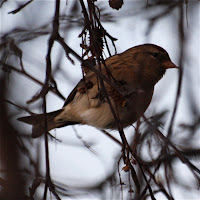
It has been a five year wait, but, at last, I happened to be outside when a Redpoll (shown below, not above!) decided to visit the garden. There have been several tantalising flyovers in the last few months, but today's bird was already in the birch tree. It was feeding unobtrusively and I only noticed it as I was adding to the compost heap right under the tree. In the ensuing scramble for the camera and contortions to achieve a camera angle I managed to slip on a decomposing Halloween pumpkin. Luckily the bird was settled... I took a series of shots as I established its identity as a Lesser Redpoll. This puts the garden list up to 69 species.
Of course, Redpoll taxonomy and identification is fraught and complex. With that in mind, it should come as no surprise that the closest relatives of the Redpolls are the Crossbills! Like that group subtle structural and morphological differences are used for segregation. In the case of the Redpolls into five (or six) recognisable(ish) forms: the Lesser Redpoll cabaret; the Common/Mealy Redpoll flammea; the North-western/Greenland/Icelandic Redpoll rostrata (often classified within flammea and may or may not include yet another form the very variable islandica which may or may not be shown in the photograph below); the Hoary/Scandinavian Arctic Redpoll exilipes; and Hornemann's Arctic/Greenland Arctic Redpoll hornemanni. And of course, other than 'classic' individuals of each form, many individual birds cannot easily or confidently be placed into one group rather than another.
 If you found that paragraph complex then there is some good news. The most recent mtDNA study has found insufficient genetic evidence for the subdivision of the Redpoll group. Instead the evidence indicates that the three species that birders are used to considering at the moment (Lesser Redpoll (cabaret), Common Redpoll (flammea, rostrata, islandica) and Arctic Redpoll (exilipes, hornemanni) should be lumped into one species - presumably: The Redpoll.
If you found that paragraph complex then there is some good news. The most recent mtDNA study has found insufficient genetic evidence for the subdivision of the Redpoll group. Instead the evidence indicates that the three species that birders are used to considering at the moment (Lesser Redpoll (cabaret), Common Redpoll (flammea, rostrata, islandica) and Arctic Redpoll (exilipes, hornemanni) should be lumped into one species - presumably: The Redpoll. Of course variation does exist within the Redpoll. It has been suggested that two well-known factors may be responsible for the variation in form of Redpolls. First, Bergmann's Rule describes the increase of size of individuals of a species with reduced temperatures. Second, Gloger's Rule descibes the increase in darkness of plumage with increase in humidity. So, these two observations would predict that the Redpolls living in western Europe would be darker, those in drier areas (such as in frozen landscapes) would be paler, those in the colder north would be larger and those living further south would be smaller.
 So the bird on the left photographed on Fair Isle in October of this year may be a Hornemann's Arctic Redpoll or may be a Redpoll from a population that has evolved in a cold and dry environment.
So the bird on the left photographed on Fair Isle in October of this year may be a Hornemann's Arctic Redpoll or may be a Redpoll from a population that has evolved in a cold and dry environment.On the other hand, it has also been suggested that these populations of Redpolls are incipient species that just have not had enough time to build up any significant genetic differences between one another.
Either way, the phenotype variation is real whether it is useful or not in assigning individual birds to genetic groups. So with that in mind, here is a selection of photographs that I took on Fair Isle in October of this year when good numbers of 'Mealy Redpoll' of a variety of plumages were present along with small numbers of 'Lesser Redpoll' and 'Hornemann's Arctic Redpoll'. It is possible that some of the Mealy-types are islandica.
Hornemann's Arctic Redpoll

Hornemann's Arctic Redpoll (with Mealy Redpoll)



Mealy Redpolls

Mealy (left) and Lesser (right) Redpolls, or maybe they are both islandica?

Mealy Redpolls islandica?
























1 comment:
Very interesting posting. Regards, Bruce Kerr, Loanhead.
Post a Comment